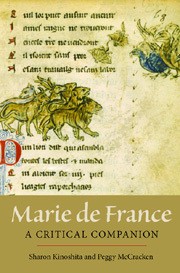Book contents
- Frontmatter
- Contents
- Preface
- Note on Editions
- 1 Introduction: the World of Marie de France
- 2 Communication, Transmission, and Interpretation: Literary History
- 3 Courtly Love and Feudal Society: Historical Context
- 4 Movement and Mobility: Plot
- 5 Bodies and Embodiment: Characters
- 6 Repetition and the Art of Variation: Narrative Techniques
- 7 Posterity: The Afterlives of Marie's Works
- Further Reading
- Index
- Already Published
1 - Introduction: the World of Marie de France
Published online by Cambridge University Press: 12 September 2012
- Frontmatter
- Contents
- Preface
- Note on Editions
- 1 Introduction: the World of Marie de France
- 2 Communication, Transmission, and Interpretation: Literary History
- 3 Courtly Love and Feudal Society: Historical Context
- 4 Movement and Mobility: Plot
- 5 Bodies and Embodiment: Characters
- 6 Repetition and the Art of Variation: Narrative Techniques
- 7 Posterity: The Afterlives of Marie's Works
- Further Reading
- Index
- Already Published
Summary
Who was Marie de France?
The works associated with Marie de France include the Lais, a collection of short narratives influenced by Celtic tales and courtly literature, probably written around 1170; a collection of fables known as the Ysopë, probably composed between 1189 and 1208 and partly translated from earlier texts; and L'espurgatoire seint Patriz (Saint Patrick's Purgatory), translated from the Cistercian monk H. de Saltrey's Tractatus de Purgatorio Sancti Patricii in around 1190. She may also have composed a Life of Saint Audrey (Vie seinte Audree), also attributed to a “Marie,” but her authorship of this text is still debated.
People have been writing about Marie de France since the thirteenth century, but all we know about her is her name and that she is the author of three, possibly four, narratives. Since the sixteenth century, critics have succumbed to the temptation to elaborate a biography around her name, and although hypotheses continue to appear, we still have no definitive evidence on which to ground any identification of Marie de France with any of the Maries attested as living in late-twelfth-century France and England.
The means by which hypotheses about authorship are formed illustrate the challenge facing modern interpreters of medieval texts. Over the decades, several different historical figures have been posited as candidates for the author Marie. The first stage in such identifications draws primarily on external evidence: locating a Marie in the historical record who was born on the Continent – preferably in Ile-de-France, the region around Paris – but documented as living in England with ties close enough to the Angevin court to presume to offer her Lais to the “noble king” Henry II.
- Type
- Chapter
- Information
- Marie de FranceA Critical Companion, pp. 1 - 16Publisher: Boydell & BrewerPrint publication year: 2012



